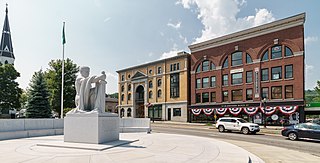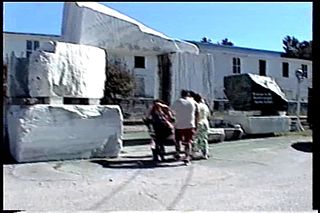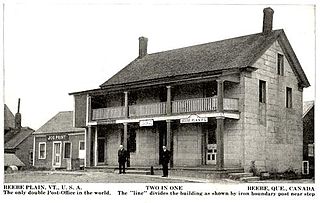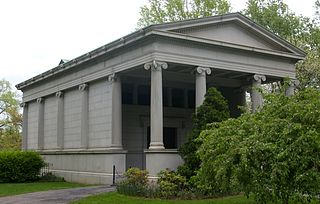
Barre is a town in Washington County, Vermont, United States. The population was 7,923 at the 2020 census, making it the 3rd largest municipality in Washington County and the 16th largest municipality in Vermont. Popularly referred to as "Barre Town", the town of Barre almost completely surrounds "Barre City", which is a separate municipality. The original town now known as Barre was first chartered in 1780 as the Town of Wildersburgh. In 1793 the name Wildersburgh was unpopular with the inhabitants and the name of the town was changed to Barre. In 1895 the City of Barre was incorporated and separated from the town of Barre, and both continue to exist as separate municipalities.

Barre is the most populous city in Washington County, Vermont, United States. As of the 2020 census, the municipal population was 8,491. Popularly referred to as "Barre City", it is almost completely surrounded by "Barre Town", which is a separate municipality.
The International Sculpture Symposium movement was spearheaded by Karl Prantl in Austria in 1959. This initiative grew from the need to facilitate communication and exchange between members of the international sculpture community. It was also rooted in Cold War tensions, which lent a particular urgency to the need for cross-cultural dialogue on a person-to-person basis. The first international sculpture symposium took place in an abandoned stone quarry in Sankt Margarethen im Burgenland.

The Vermont Marble Museum or Vermont Marble Exhibit is a museum commemorating the contributions of Vermont marble and the Vermont Marble Company, located in Proctor, Vermont, United States. The museum is located in a wing of one of the former Vermont Marble Company buildings.

Beebe Plain is an unincorporated geographically-contiguous settlement, split politically between Canada and the United States. An unincorporated village partially in Stanstead and partially in Derby Line, it is divided by the Quebec-Vermont border. This settlement was begun by David and Calvin Beebe in 1798.
The Washington County Railroad is a shortline railroad operating in Vermont and a sliver of New Hampshire, forming part of the Vermont Rail System. The WACR began operating in 1980 over the old Montpelier and Barre Railroad in Washington County, which the state acquired to ensure the continuance of rail service, and ceased operations in early 1999. Later that year, after interim service by other companies, operations were transferred to a new WACR subsidiary of the Vermont Rail System. In 2003, operations were greatly expanded through acquisition by the state and operation by the WACR of a former Boston and Maine Corporation and Canadian Pacific Railway line between Newport and White River Junction, which had most recently been operated by subsidiaries of the bankrupt Bangor and Aroostook Railroad.

Graniteville is a census-designated place (CDP) in the town of Barre, Washington County, Vermont, United States. The population of the CDP was 784 at the 2010 census. Prior to 2010, it was part of the Graniteville-East Barre CDP, which consisted of three unincorporated villages in the town: Graniteville, East Barre, and Websterville.

Wade Memorial Chapel is a Neoclassical chapel and receiving vault located at Lake View Cemetery in Cleveland, Ohio, in the United States. It was donated to the cemetery by Jeptha Wade II in memory of his grandfather, cemetery and Western Union co-founder Jeptha Wade. The overall design was by the newly-founded Cleveland area architectural firm of Hubbell & Benes, and was their first commission. The interior's overall design is by Louis Comfort Tiffany based on a preexisting 1893 design. The interior features two mosaics on the right and left hand walls, and a large stained glass window.

Hope Cemetery is a rural cemetery in Barre, Vermont. The city calls itself the "Granite Capital of the World", and the cemetery is known for the superb granite craftsmanship on its memorials and tombstones. Barre is also home to the world's largest "deep hole" granite quarry, the Rock of Ages quarry, also known as the "E. L. Smith Quarry".

Barre granite /ˈbæri/ is a Devonian granite pluton near the town of Barre in Washington County, Vermont. Richardson described it as a "fine granite, composed of quartz, feldspar, and mica. The mica is both muscovite and biotite." It intrudes into the Waits River Formation.
Coldspring is a quarrier and fabricator of granite and other natural stone and a bronze manufacturing company in the United States. Coldspring serves the memorials market, the design and architectural market and distributes slabs for the residential market, industrial products, raw quarry blocks, and diamond tools...

Hollister Jackson was the 56th lieutenant governor of Vermont; he was killed in the Great Flood of 1927.
Frank Chalfant Gaylord II was an American sculptor best known for "The Column", a sculptural tableau of United States soldiers and sailors which is part of the Korean War Veterans Memorial in Washington, D.C.

The United Nations Memorial Cemetery in Korea, located at Tanggok in the Nam District, City of Busan, Republic of Korea, is a burial ground for United Nations Command (UNC) casualties of the Korean War. It contains 2,300 graves and is the only United Nations cemetery in the world. Laid out over 14 hectares, the graves are set out in 22 sites designated by the nationalities of the buried servicemembers.

The Spanish–American War Soldier's Monument, also known as the Spanish–American War Memorial or simply Soldiers Monument, is an outdoor sculpture and war memorial monument honoring the dead of the 2nd Oregon Volunteer Infantry Regiment of the Spanish–American War and Philippine–American War. The monument was created by American artist Douglas Tilden and located in Lownsdale Square, in the Plaza Blocks of downtown Portland, Oregon. It features a bronze statue on a marble pedestal and granite base. The monument is part of the City of Portland and Multnomah County Public Art Collection courtesy of the Regional Arts & Culture Council.

The Woodbury Granite Company (WGC) was a producer of rough and finished granite products. Incorporated in 1887, purchased and significantly reorganized in 1896, and expanded by merger in 1902 and thereafter, the company operated quarries principally in Woodbury, Vermont, but its headquarters and stone-finishing facilities were located in nearby Hardwick. Beginning as a quarrier and seller of rough stone, the company expanded into the business of finishing cut stone and grew from there. It made its name as a supplier of architectural (structural) granite, and grew to become the United States' largest producer, supplying the stone for many notable buildings, including several state capitols, numerous post offices, and many office buildings.

Green Mount Cemetery is a burial ground in Montpelier, Vermont. Located at 250 State Street, the 35-acre facility was established in 1854. It is operated by the City of Montpelier, and managed by the city's part time cemetery commission and a small full-time staff.















